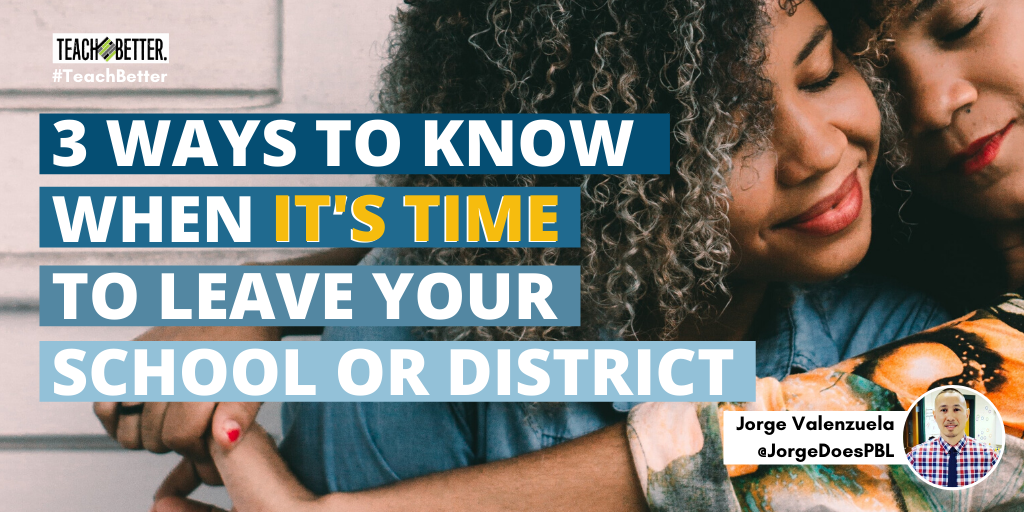TL;DR:
- A personal story and reflection of leaving a position.
- 3 signs it’s time to leave your current position.
- Suggestions for self-reflection to determine your next steps.
In 2016, I was at a crossroads and needed to be challenged professionally. As I contemplated leaving my district position, I knew it was time for me to go. But I had a lot of fear and anxiety about my next steps and how I would be able to take care of my family financially.
Luckily, I received advice from a mentor who said, “Only seek advice from those who have already accomplished what you want to accomplish. It’ll remove part of the learning curve for you.”
I then reached out to a trusted thought partner, Dr. Charity Moran (CEO of iDoSchool), and sought her counsel.
Dr. Moran helped me examine my skillsets to deem what aspects of my work were marketable and valuable to others. Since I already had some previous success facilitating workshops nationally, she recommended I begin to make others more aware of my good work. I started by blogging about my teaching experiences regularly and continued by allowing colleagues and prospective clients to view my work on social media.
Is it time to take the leap?
Honestly, at the time, her advice freaked me out and made me nervous. I now realize my anxiety about showing my work to others was due to a lack of confidence. Guessing that she sensed this in me, Dr. Moran gave me a wonderful gift, the audiobook ‘Leap: Leaving a Job with No Plan B to Find the Career and Life You Really Want’ by Tess Vigeland.
If you’re like me, I am pretty sure that part of the title ‘Leaving a Job with No Plan B to Find the Career and Life You Really Want’ makes you skeptical. It did for me initially.
However, it is very important to understand that a ‘leap’ should only be taken after developing a marketable range of skills first. This means that one needs to build his or her expertise at their craft before leaving a job. BUT he or she should also be comfortable not knowing what all the next steps may be.
Let’s face it, a career can take years to figure out. And it’s ok to try out different schools or positions until we find our jam. What’s not ok is to not prepare ourselves. We should always put our best foot forward, so we can be more comfortable with whatever our next step may be.
If you’re currently contemplating making a change but are unsure of next steps or even doubting what you’re feeling, you’re not alone.
Here are three ways to determine if it is time to leave, along with some actionable steps to prepare you for your exit.
It doesn’t matter how we share our work as long as we do with the intention of helping others. Click To TweetSign #1 That It’s Time to Leave: Your intuition is telling you
Intuition is often described as something that one either considers or knows from an intuitive feeling rather than from deliberate reasoning. Others call it a ‘sixth sense’ or an ‘inner voice’ meant for helping to guide us.
Regardless of what it is, I believe it is important to pay attention to the feelings we continuously experience and do something about them. When I was contemplating leaving my district, I was fearful about the possibility of losing my livelihood. Therefore, I ignored my gut and, for many long months, stayed in a position that no longer served my professional growth.
I realize now that doing this caused me unnecessary mental anguish. It was not self-loving or productive in the least. I’m not suggesting immediately leaving a job we don’t want to be in simply because we’re not happy. But I don’t believe we should prolong staying either.
According to findings published in the Journal of Psychological Science, researchers devised a method for measuring intuition. They have found that, after its application, the evidence suggests that people can use their intuition to make quicker and more accurate decisions.
Steve Jobs once said, “I have looked in the mirror every morning and asked myself: If today were the last day of my life, would I want to do what I am about to do today? And whenever the answer has been ‘No’ for too many days in a row, I know I need to change something.”
I find a lot of wisdom in Steve’s quote. In the past few years, I have learned to trust my intuition more by trusting my preparation. I now encourage others to do the same. Moreover, I have found this practice helpful for pursing the right relationships, business opportunities, making smart purchases, and wise investments.
Here are a few of the steps I have taken to ensure success while still learning to trust myself and my intuition:
- Sleep on it patiently — at least for a few days.
- Talk to a trusted friend, colleague, or mentor. Choose someone who has already successfully navigated similar waters to yours.
- Map your outcome backwards. This step will teach you what you need to know and do prior to making the next step.
- Pray and mediate on it. I believe that we all need something to believe in. It’s best to exercise this practice daily.
Sign #2 That It’s Time to Leave: You are only valued for your yes
Unfortunately all of us, at some point, will encounter people that only value us when we either agree with them or comply with their wishes. This is our yes.
Such one-sided relationships can be extremely difficult to endure and navigate. Especially when the perpetrators are your building administrator, direct supervisor, or the colleagues you need to work with closely. When emotions run high, and we don’t feel valued, validated, or welcome, it is essential to step back to determine if our feelings are justified in relation to what we’ve experienced.
Here are some telling signs that we aren’t being valued beyond our ‘yes’:
- Their words and actions cause you to continually second-guess yourself.
- You feel worried and insecure about your current standing with the perpetrator(s).
- They are controlling of your time and priorities.
- Supporting what you need to do for students is ONLY their priority when it makes them look good.
- You do all of the required work to make the relationship work, but they don’t put forth the same effort(s).
- You apologize to them when you don’t have to, AND they enjoy it.
- They are not invested in your personal or professional growth.
If the answer is yes to any of the aforementioned bullets, at the very least, it’s time for a conversation. But if the answer is yes to more than one, do the loving thing for yourself and RUN (metaphorically speaking).
I say this because collegiality and professionalism should always be a top priority. Especially when dealing with our fellow teachers and building administrator. Research tells us that that collegiality among educators plays a pivotal role in enhancing student performance, job satisfaction, school quality, and commitment to shared vision between the school staff and its stakeholders.
So, if we don’t feel that collegiality is present in our school or district or that ‘our yes’ isn’t reciprocated, how can we get to the actual purpose of educating our students?
Before running for the hills, here are a few steps to take for improving your current situation:
- Respectfully call them out for the injustice. Don’t do this publicly, allow them to keep their dignity, and ALWAYS speak respectfully. Understand that if you do not take this step — YOU are allowing it to occur.
- Reflect on how you contributed to any of the issues at your school, the areas you need improvement on, and then act. For this purpose, I highly recommend that educators set aside at least 30 minutes a day to read, learn, and work on their craft.
- Find your people. Sometimes you are not able to leave right away because you need to honor your contract and line up your next opportunity. But that doesn’t mean you need to remain unhappy for the remainder of the time you are there. Seek out some like-minded educators and join their PLN.
- When you exit, do not burn bridges. You never know when you will need to cross the same bridge twice. Therefore, forgive, move on, AND always exit gracefully. An excellent practice is to express gratitude for both your time and experiences at your school/district to those you leave behind.
I genuinely want to stress to the reader that this step is MORE about self-love and LESS about those who don’t value us beyond what we can do for them.
Being kind to ourselves may be difficult when we feel uncertain. But I believe it’s vital that we learn to do so for our own self-worth and, most importantly, the work we do with learners.
And though it could be our tendency to blame ourselves for someone else’s poor behavior, remember this great quote by Paulo Coelho, “How people treat other people is a direct reflection of how they feel about themselves.”
Sign #3 That It’s Time to Leave: It’s time to grow differently
At times, leaving our school or district is solely related to personal and professional growth. I learned this when a good friend of mine left her post with a terrific consulting firm, one that many consider being the ‘BIG leagues’ in our field.
When I asked her about it, she told me that her decision had nothing to do with anyone in particular, only herself. She further expressed that she’s been at her craft for years, and that she needed to grow in a way that the organization couldn’t support at this time.
At first, I thought her move was courageous, but with time, I realized that her move was a confident one. That was a big lesson for me. I understood that the realization she had about her own growth was earned over time. It required specialized expertise.
For earning this knowhow and professional freedom, I always encourage friends and colleagues to make time for improving their craft. Specifically in the two areas of planning and facilitating instruction. It is useful to do this while also documenting and celebrating students’ good work via a blog, podcast, video or in social media.
[scroll down to keep reading]
It doesn’t matter how we share our work, as long as we do so with the intention of helping others.
Continuously apply these items, and you’ll enhance our profession in the following ways:
- Doing what’s best for kids.
- You’ll always be growing personally and professionally and improving your pedagogical strategies.
- Sharing stories with other educators who need the inspiration AND wisdom.
Never abandoning our professional growth puts us in the unique position of intuitively knowing what our next step is. Which means that no one will have to tell us what it is.
Last word
Each of us is unique. But with passion, dedication, and time we can all be impactful in our classroom or district. However, knowing when to stay or go may seem a bit daunting and, at times, feel like a dire necessity. I believe the key is to always listen to the right people, take measured steps, and do all things with love.
ABOUT JORGE VALENZUELA
Educational coach Jorge Valenzuela is new to the Teach Better Team, a teacher at Old Dominion University and the lead coach for Life Long Learning Defined. His work is aimed at helping schools understand and implement computational thinking, computer science, STEM, and project-based learning. Currently, Jorge presents nationally on these topics; is an award winner, the author of Rev Up Robotics, an education advocate, and frequent contributor to books, academic journals, how-to blogs, podcasts, and webinars. Jorge is also a member of the Teach Better Speakers Network.



